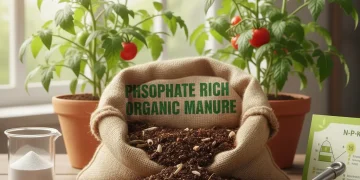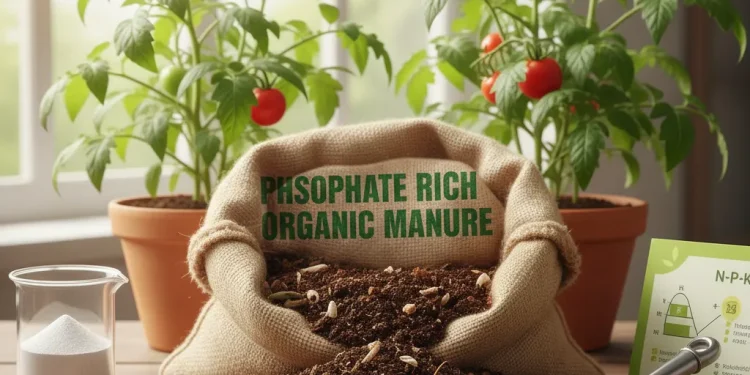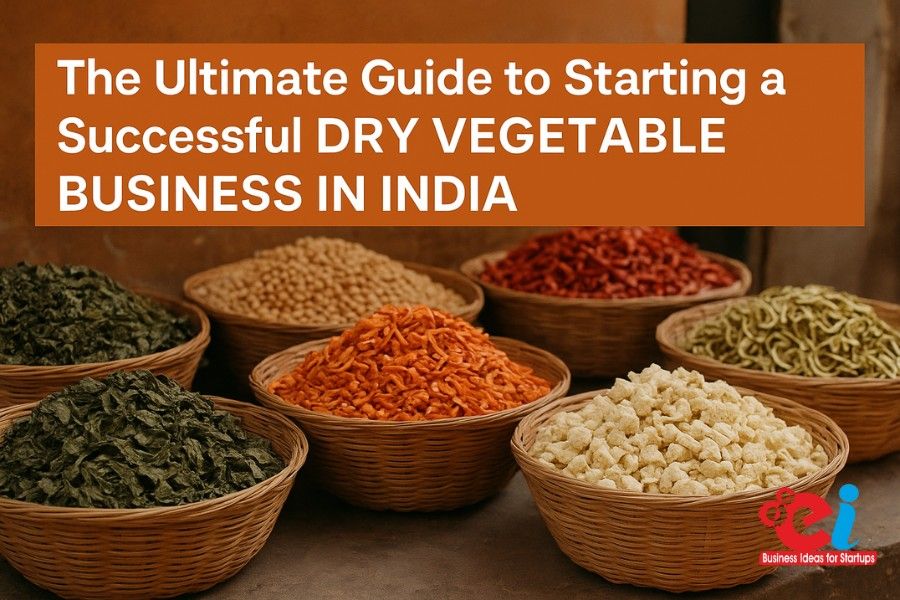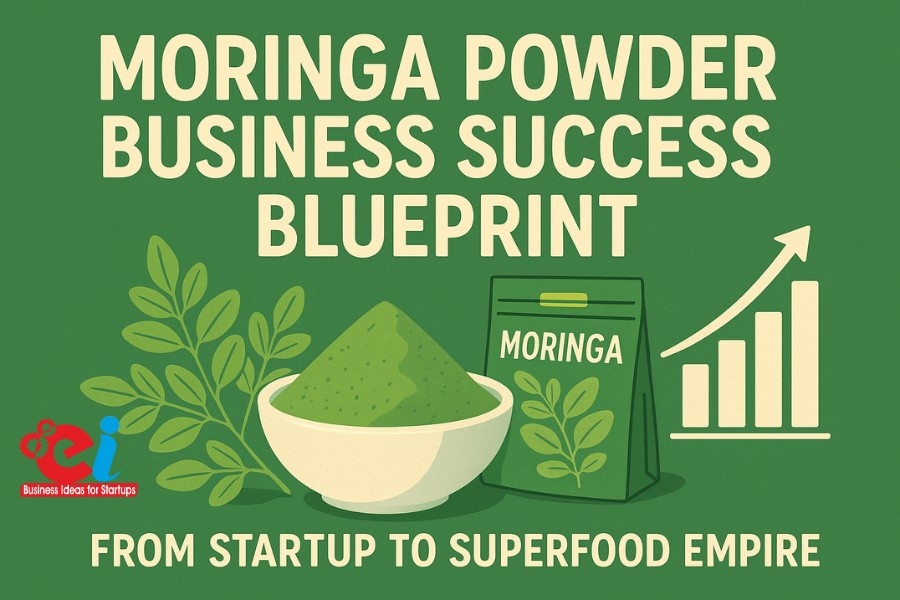Phosphate Rich Organic Manure (PROM) brings the power of your now and future dignity. Keep in mind that before you get, there is something special that you are in favor of the PROM. First, the PROM can supply phosphorus to your plants. Second, it adds organic matter for the soil itself.
Now you will benefit from a clear guide to using Phosphates Rich Organic Manure. Everything is based on it, step by step.
How the PROM works – Basics
This part will deal with this section: How it promises things before converting them. The phosphate of the rock itself is not mixed with the soil. But when you connect it with organic matter, there is a new result in the mix.
When organic matter of microbes are produced. These acids release phosphorus from rock phosphate.
The work of some bacteria, mushrooms and viruses is to produce these special acids and enzymes.
Conversely, if you have a lot of organic substances, soil biology can be maintained in good condition and nutrients move well.
Softer phosphate of ground rocks, the better it works because it will mix well with the soil, so it dissolves quickly. In this way, the PROM is slowly released, but also accelerates the soil construction.
Read Our Book: Click Here
How to Make PROM – Simple Steps
The following plan produces the PROM in a simple way and works well.
Select the materials
Choose high -quality phosphate with safe phosphorus levels and low heavy metals. Also, make sure that the organic waste used is safe, without harmful substances.
When selecting, look for not only for source compost or fertilizer, but also in mind the nitrogen level; One should be lower than the other to help maintain balance.
Grind rock
Rate rock phosphate for fine powder. The finer it is, the faster it works.
Create compost
Start with compost that has the correct carbon and nitrogen balance. Then the process itself remains healthy.
Mix the rock and compost
Crush the rock phosphate and mix it with the compost. Mix well so no parts are lumpy.
Add microbes (optional)
You may want to add microbes to help you release phosphorus. If so, select familiar types such as bacillus or pseudomonas.
compost
You should keep the hall in place with good air stream. Follow the correct level and humidity temperature. Turn it from time to time and reach the vertex in the process of curing and fragrance cleanly when it happens.
Complete and quality test
Test the product for water, phosphorus, organic carbon, nitrogen, pH and metals. Dry all lumps. Then wrap it and store the PROM in sealed bags, keep dry and out of light.
Read Our Project Report: Click Here
Key quality parameters and farm testing
Several factors should be taken into account before using the PROM. When this happens, not only the Earth but also your crops is protected.
Total p₂o₅: This number shows how much phosphorus is currently inside the PROM.
In water soluble P and citrate soluble P: These two characters tell you about the availability of phosphorus in plants and later.
Available nitrogen (N) and organic carbon: These nutrients are symptoms of benefits that Prom can bring to your agriculture.
Moisture content: Farmers should try to have less than 25%to make easy storage and spread of the PROM.
PH: Prom should not be too alkaline or too acidic.
Heavy metals: Promé must prove toxic metals (lead, cadmium, arsenic) to make the crops safe.
Pathogens: For example, those that may be in biosolides or manure. Testing bacteria helps ensure safety in harvested foods.
Read More: Biofertilizer and Phosphate Rich Organic Manure (PROM) Manufacturing Plant
Application and Methods- Practical Guide
You must adjust the Prom Make due to the differences between crops and local conditions. Always let the soil test before using.
Cereals (wheat. Corn, rice): 200-400 kg of hectare promotion during vaccination. For a rapid growth of time consider inserting some other nitrogen or soluble P beside it.
Pulses: 150-300 kg/ha. Pulses pulls out from their root bacteria and promises to increase this process.
Oil (soya, rape): 200-400 kg/ha for seeds or season before building the store.
Vegetables and crops with a high value: band 100-300 kg prom/ha or apply before seed. Add soluble P when transplantation if the plant needs a good start.
Orchars and permanently: a tree dose: 0.5-1 kg per tree every year, 2-10 kg to the root zone for older trees.
Pastures and forage: Level 150-350 kg/ha is wise to spread based on soil results and how hard they are sheep.
Read More: Production of PROM (Phosphate Rich Organic Manure)
Important events
Check soil phosphorus levels like Olsen or sometimes Bray.
Combine with crop roots for better results.
Combination of PROM with sound agronomy: limitation of acid soils, ensuring adequate control of nitrogen and potassium and moisture.
Timing and integration with a crop system
If possible, apply the PROM well before the highest demand P P, because it looks slow.
Integrate Prom into crops alternation and gradually build and maintain soil P.
Use partial soluble P for immediate needs: Farmers often stir the PROM with lower doses of soluble fertilizers P to ensure early growth while the PROM creates the ground P over time.
Economics: Costs, benefits and return on investment
When using local rock phosphate and manure on the farm, Prom can bring you economic benefits and cost savings. However, with soil grain performance, it usually increases: it is development over time.
If we calculate the added value of Prom Plus all other factors and then deduct costs, the return on investment of increased return is higher. Simply. Most farms quickly see the advantage of a combination of PROMs with sound agricultural procedures after one to three seasons.
Subsidies and organic certification can increase your return depending on where the farm.
Environmental Benefits and Risks of PROM
Let’s see what uses the use of Prom (organic phosphate -rich fertilizer) for the environment. There are clear benefits and risks.
Advantages:
It reduces phosphorus drainage: it promises phosphorus slowly, so it does not quickly pollute and pollutes the rivers and lakes.
It helps carbon in the soil: adding organic matter from the promise of another carbon in the ground. This makes the soil better in keeping water and handling dry weather.
It supports recycling: the use of the remaining organic materials for promises to keep waste outside the landfills and allows farmers to reuse nutrients.
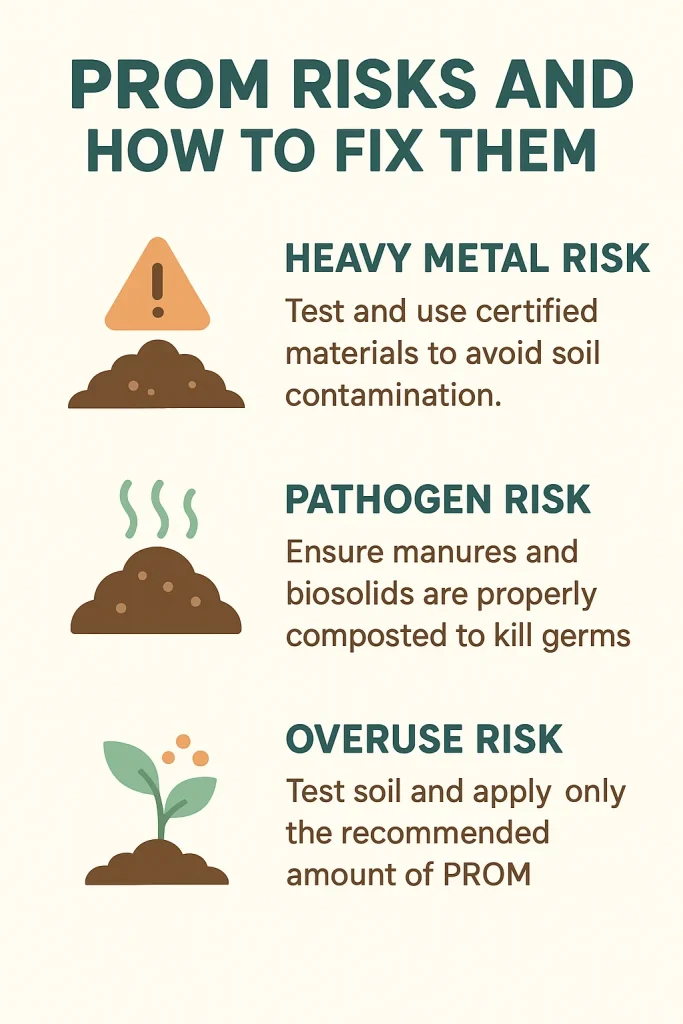
Risks and how to fix them:
Remember several risks and ways to avoid problems before using Prom.
- Heavy metal risk: if your default materials have heavy metals, they can accumulate in the soil. Always use tested, certified materials and constantly check safety.
- Risk of pathogens: fertilizers and biosolides require proper composting. Make sure the pile heats up enough to kill all bacteria.
- Excessive risk: Using too many promises more phosphorus than plants need. First try the soil and use only the right amount.
Certification, regulations and needs on the market
Preparation of the PROM for the market is important. Here’s what manufacturers should keep in mind.
- Organic certification: Use only allowed materials and correct methods. Make sure your product meets the rules of your certification agency.
- Marking: Provide clear information about the content of phosphorus, organic carbon, moisture and safety.
- Quality Ensuring: Try every dose, keep the records and watch where your inputs come from.
- Follow the standards: Always match the national standards for safety and nutrient fertilizers.
Problems removal: Avoiding common problems
You can apply some problems when using the PROM . Here are fast solutions.
- Weak early plant growth: Prom works slowly. Place a small piece of rapid release of phosphorus near seeds to help them start strongly.
- It does not work in alkaline soils: add something that causes the soil to be less alkaline or grind PROM finiter or add useful microbes.
- Ominous fragrances or health risks: compost fully and keep the process hot enough to kill bacteria and get rid of any odors.
- Clumping or bonding: Keep the PROM dry and sealed against moisture.
Read More: PROM Fertilizer: Unlocking the Potential of Soil with Phosphate Rich Organic Manure
Helping Farmers Use PROM
Farmers need good advice and practice. Here’s how to support them.
- Demonstration charts: Show real results by planting side by side with Prom and standard fertilizers.
- Training and extension: Teach farmers to manage, compost and test their land.
- Micro-UNITS: The establishment of small promoters near farms for fresher products and more local jobs.
- Agricultural cooperatives: Money and equipment for lower costs for all.
Advanced: mixtures, microbes and smarter use
With Prom you can do more by mixing and comparing for better results.
- Add biofertilizers: Use useful bacteria or fungi to strengthen phosphorus absorption in crops.
- Precision Banding: Place the PROM in narrow stripes near the roots.
- This makes it easier for plants to obtain nutrients.
- Use leaf sprays: Put more nutrients on the leaves to support growth until it starts to work.
How can NPC S help
Starting of the promotion requires significant preparation and planning; As a result, advice as NPCS (NIIR Project Consultancy Services) can be invaluable.
The NPCS cooperates with individuals and companies to provide comprehensive support services in the preparation of in -depth reports on projects describing the costs, equipment, space, staff and income to develop a comprehensive business plan adapted to your budget and market characteristics.
With the provision of extensive market survey, they will help you understand the level of demand, suppliers and competition. Their feasibility studies can also help you verify the location, size and financing of business.
Finally, they can help your business in navigation in government policies, obtaining the required amounts of subsidies or ensuring financial approval.
Their range of consultations is widely usable to start your business, allowing you to eliminate the risk, reduce errors and easier and profitably enter your business.
Find the Best Idea for Yourself With our Startup Selector Tool
Conclusion
Promises brings together nutrient regeneration and soil regeneration. If it is properly produced and used, it leads to less reliance on synthetic fertilizer, better soil fertility and prosperous yields.
FAQS
How long before Prom gives enough phosphorus for the crop?
Promises P gradually. Some increases in available P may occur in weeks, but full benefits often increase during the season or several cycles of crops. Use a small starting dose of soluble P for immediate needs.
Can Prom be used in organic farming?
Yes, Prom is suitable for organic systems if you use inputs approved organically and monitor certification rules. Ensure that no prohibited materials are used (some biosolides, untreated waste sludge).
Will the promotion of phosphorus in the soil cause?
If you apply without soil testing and exceed the needs of crops, P can accumulate. Therefore, routine soil testing and calibrated application rates are necessary.
How cheaply do I test the quality of the PROM ?
Basic laboratory tests include total P (p₂o), water soluble P, organic carbon, moisture and pH. For quick check -ups, use the soil testing sets to monitor the available P after application.
What are the affordable ways to produce a PROM on the farm?
Use local rock phosphate, co-composting with agricultural fertilizers and crop residues, maintain good humidity and aeration and allow a period of curing. Simple inoculating packages of solubilizing phosphate bacteria can increase performance.
